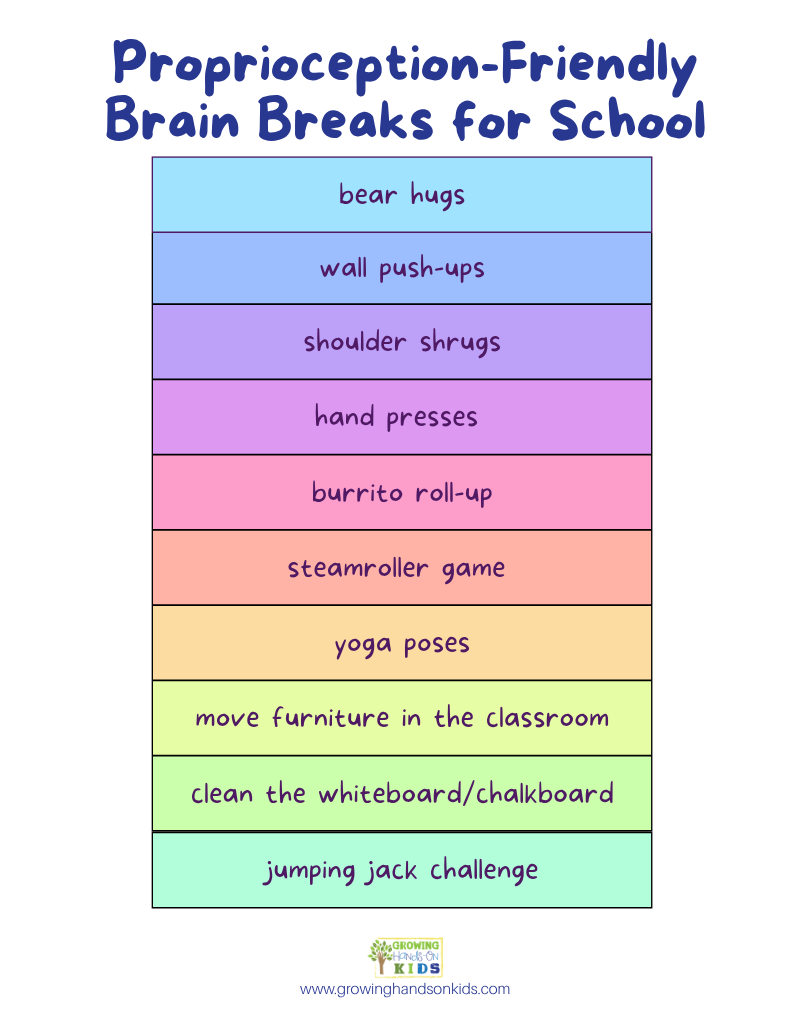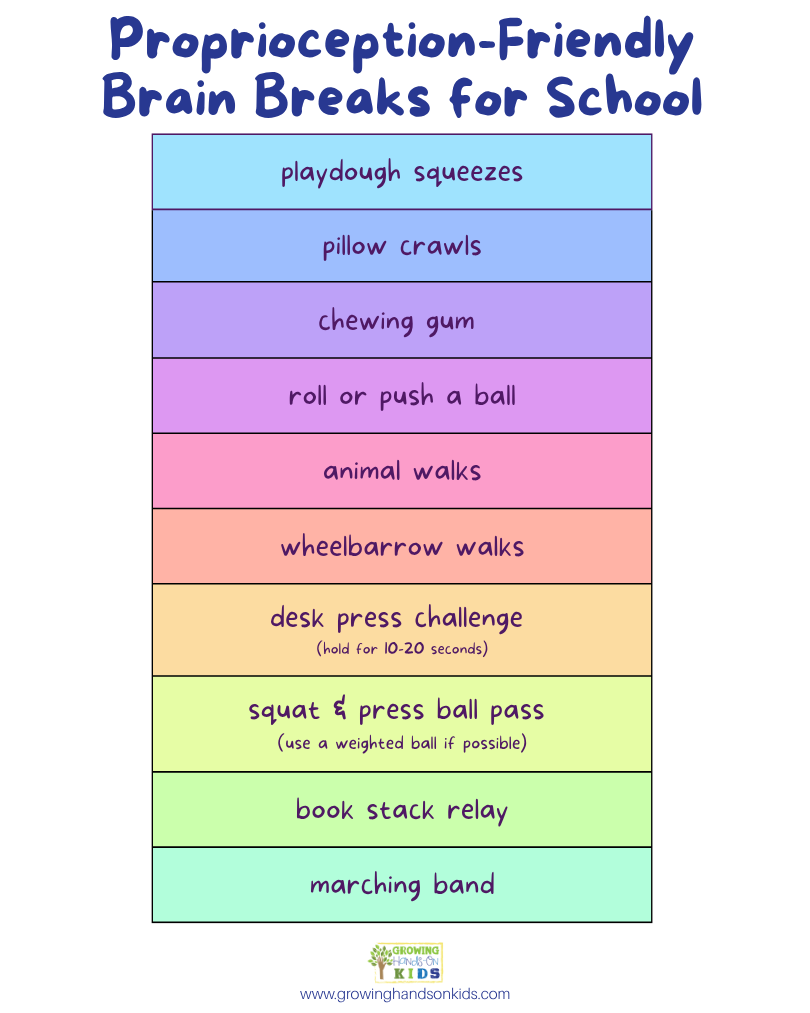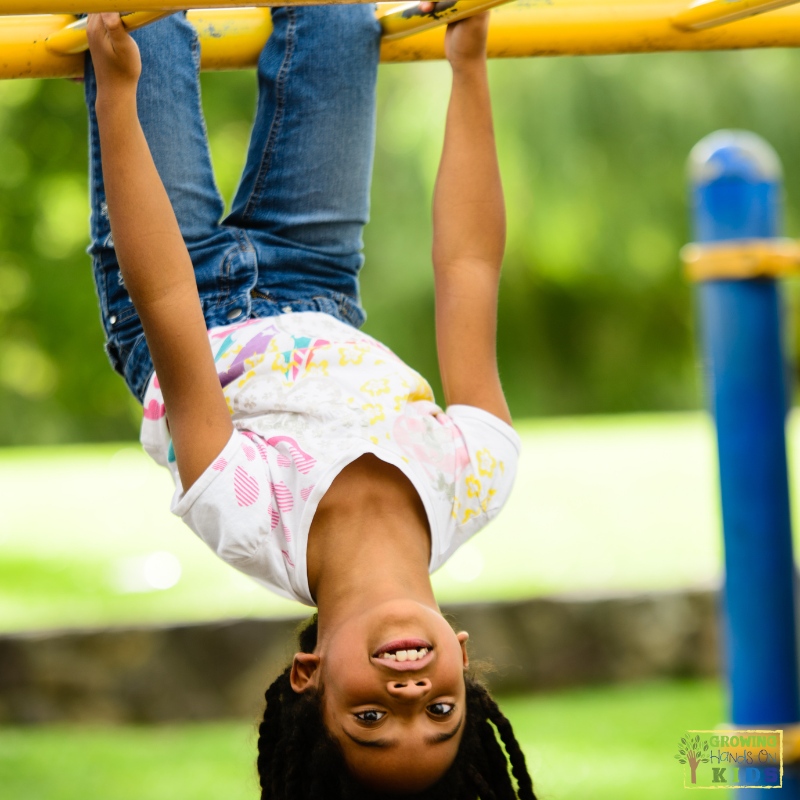Proprioception-Friendly Brain Breaks for School
Affiliate and Referral links are used below to promote products I love and recommend. I receive a commission on any purchases made through these links. Please see my disclosure policy for more details. As an Amazon Associate, I earn from qualifying purchases.
There are so many benefits to having brain breaks, or movement breaks, throughout the school day. Last year, I shared that my children started attending school after being homeschooled, which inspired me to share some classroom-friendly proprioception-activating brain break ideas.
What is Proprioception?
In short, proprioception is part of our sensory system and is responsible for our sense of body awareness. The sensors are located in our muscles, joints, and ligaments, and help our body know where it is in space and in relation to things around it.
Proprioceptive input can have a calming and organizing effect on many children and is a great option to have for brain breaks throughout the day. You're probably already including many activities that include this type of input. But it's always great to have a list of classroom-friendly ideas to pull from when you need to mix things up.
Classroom Friendly Proprioceptive Brain Break Activities
1 || Bear hugs
Have the students wrap their arms around their torso and give themselves a big bear hug. You can have them hold this for 15-20 seconds and repeat as needed.
2 || Wall push-ups
Use spot markers hung on the wall, or Post-it notes, to mark where the children can place their hands if needed. Have the children line up and complete 5-10 wall push-ups.
Some children will not want to bend their arms all the way, leaning completely into the wall. I always give a visual prompt/cue before starting and remind them to touch their nose to the wall with the push-ups. You can also put a spot marker on the floor to mark where they need to stand in order to do this without losing their balance.
3 || Shoulder shrugs
Lift shoulders toward the ears, hold for a few seconds, then release.
4 || Hand presses
Students can make a tight fist, squeeze for 3–5 seconds, then slowly release. They can repeat this several times or squeeze a small object like a stress ball, play-dough ball, or soft toy.
Check out these hand exercise warm-up activities for more ideas.
5 || Burrito Roll-Up
Grab a blanket and have each child take turns rolling up in the blanket like a burrito. Make sure their head is outside of the blanket.
6 || Steamroller game
An adult or peer gently rolls a large therapy ball, heavy pillow, or foam roller over the student's back, legs, and arms, like a “steamroller.” The slow, consistent pressure gives strong proprioceptive feedback to the muscles and joints.
7 || Yoga poses
There are many great yoga poses out there for proprioceptive input. Some of them could include: plank, warrior, table-top, downward-facing dog, plow, etc.
A couple of my favorite yoga resources for kids include Kids' Yoga Stories and Cosmic Kids Yoga.
8 || Move furniture in the classroom
Any time you want to move furniture around or change up the seating arrangments/desks, have the students help by moving the furniture around the room.
9 || Clean the whiteboard/chalkboard
While many schools may be moving to smart boards, if your classroom has a whiteboard or chalkboard, make sure cleaning it off is one of the student jobs. This can be rotated among the students in the class for the day or assigned for the week, etc. You are also sneaking in some bilateral coordination with this activity.
10 || Play dough squeezes
Squeezing play dough is great proprioceptive input for the hands. It's also a great way to warm up before any type of handwriting or typing activity.
Sensory-Friendly Classroom Starter Kit (Instant Download)
I want to take a quick break to tell you about our sensory-friendly classroom starter kit. Incorporating sensory-friendly strategies into your classroom not only benefits children with sensory processing challenges but also enhances the learning environment for all students. Our Sensory-Friendly Classroom Starter Kit equips you with everything you need to foster a more inclusive, calming, and engaging space for children of all abilities.
11 || Pillow crawls
Make a pile a pillows on the floor and have students crawl through them. If you don't have pillows in your classroom, but your gym has a ball pit or foam blocks, you can use those for the same effect.
12 || Chewing gum
Yes, there are proprioceptive receptors in the mouth. If you have a student who chews on clothing or pencils a lot, having something that they can chew on is great. This needs to be something that is okay with school policy, parents, and also monitored. Chewing breaks can be integrated into independent reading time or any type of seated work.
13 || Roll or push a ball
Divide the children up into pairs and have them sit on the floor and roll and ball back and forth. Use a weighted ball for more proprioceptive input. If you don't have access to a weighted ball, a larger ball like a basketball or volleyball would work well.
14 || Animal walks
Younger children will especially love this activity. Have children pretend to be different animals, such as crab walk, bear walk, frog jumps, or an inchworm crawl.
Check out my farm animal movement cards here.
15 || Wheelbarrow walks
Divide the children up into partners/pairs and have a good old-fashioned wheelbarrow walking challenge across the classroom. One student holds the ankles while the other “walks” on hands across the room.
You can set up a finish line using painter's tape on the floor and time each team. Or just set a 5-minute timer and have them do as many as they can in that time period.
16 || Desk-press challenge
While sitting, push down into the desk as if trying to push it into the floor for 10 seconds. You can see if they are able to lift their bottoms off the seat and gently sit back down again.
17 || Squat & press ball pass
Squat low while passing a medicine ball (or weighted ball substitute) around the circle.
18 || Book stack relay
Gather all the books in the classroom and have a stacking relay race.
19 || Marching band
Use musical instruments in your classroom, or assign imaginary instruments and have your children march around the classroom as a marching band. You can include some band music or upbeat classical-style music to take this activity to the next level!
20 || Jumping Jack Challenge
You can play this a few different ways. Have the class do 20 jumping jacks at once, time them to see how long it takes them to do 20-30 jumping jacks, or do it minute-to-win-it style.
If a child has difficulty with doing jumping jacks, l always give a visual demonstration while telling them to start with their arms at their sides. You can have them start with just their legs jumping in and out, and then add their arm movements. Tell them to make their body straight like a pencil with their arms above their heads.
I've found that many children will stop their arms at their shoulders and not bring them up above their heads when doing the jumping jacks. So just remember to prompt them to move their arms all the way up.
Regulating Before Seated Work
With any type of proprioception or vestibular activity that tends to activate the sensory system, you need to follow it with some regulating or calming activity before going back to seated work. I like following many of these activities with some guided breathing or yoga poses to help everyone get back to a just-right level for focus and attention.
Some of the activities above can also double as a regulation activity before going back to a more focused time. Things such as the steamroller, play dough squeezes, hand squeezes, bear hugs, and yoga poses are all great transition activities to use after activities that tend to alert and bring energy levels up.
Free Proprioceptive-Friendly Brain Breaks for School Handout
Subscribe to Growing Hands-On Kids for my weekly newsletter and get a free printable of the proprioceptive-friendly brain break ideas for the classroom.
When you subscribe to my email list, you'll also be the first to know about new printables or products I create and recommend.
If you have already subscribed to GHOK, don't worry, you aren't subscribing again. Entering your email below lets my email service provider know which printable download to send you. You will not receive duplicate emails from me in the future.
You May Also Like:

Heather Greutman, COTA
Heather Greutman is a Certified Occupational Therapy Assistant with experience in school-based OT services for preschool through high school. She uses her background to share child development tips, tools, and strategies for parents, educators, and therapists. She is the author of many ebooks including The Basics of Fine Motor Skills, and Basics of Pre-Writing Skills, and co-author of Sensory Processing Explained: A Handbook for Parents and Educators.


.png)



